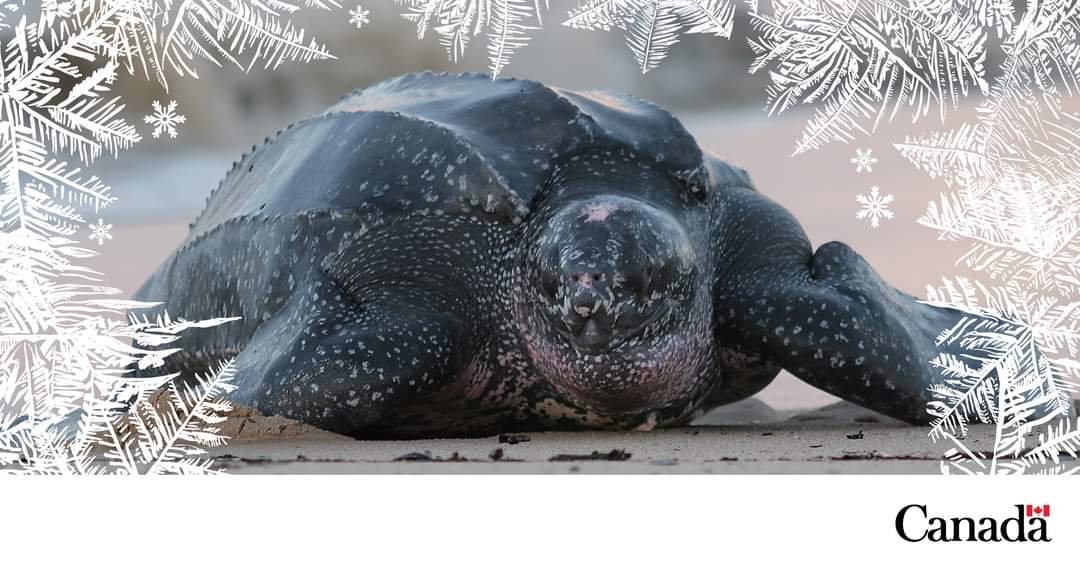**** DFO Media Release
Leatherback Sea Turtle (Dermochelys coriacea), Atlantic population
The female leatherback sea turtle can lay clutches of up to 90 eggs several times during the nesting season!

Range
New Brunswick, Newfoundland and Labrador, Nova Scotia, Prince Edward Island, Quebec, Atlantic Ocean
Description
The Leatherback Sea Turtle is 1 of 7 species of marine turtles in the world. It evolved around 100 million years ago and co-existed with the dinosaurs. The species is named for its characteristic leathery shell, which differs from the bony shells of the other 6 marine turtle species. The shell is shaped like a teardrop with 7 distinct dorsal ridges tapering at the tail. Leatherback Sea Turtles are bluish-black in colour with scattered white blotches and have very large paddle-shaped front flippers. The underside of the turtle, or plastron, is mostly pinkish-white. Each adult has a uniquely patterned “pink spot” on the top of the head, which is believed to play a role in prompting migration by responding to seasonal changes in daylight. The adult Leatherback Sea Turtles that frequent Atlantic Canadian waters have an average curved carapace (shell) length of approximately 1.5 m and an average weight of approximately 400 kg. (Updated 2017/05/16)
Distribution and population
The Northwest Atlantic subpopulation of Leatherback Sea Turtles ranges throughout the North Atlantic Ocean, spanning from low latitude nesting beaches to northern foraging areas reaching approximately 50°N. The most recent assessment of this subpopulation, conducted by the International Union for Conservation of Nature (IUCN), estimated the number of mature individuals to be between 29,000 and 34,000. The trend for this subpopulation appears to be increasing; however, globally, the species is in decline. Over 1,000 Leatherback Sea Turtles are thought to visit Atlantic Canada each year to feed. While in Atlantic Canada, these animals have been recorded in waters as shallow as 2 m and as deep as 5,000 m. The vast majority of sightings occur within the 200-m isobath. (Updated 2017/05/16)
Habitat
Leatherback Sea Turtles are found in the temperate, subtropical and tropical waters of the Atlantic, Pacific and Indian Oceans. They are migratory animals, with adults travelling up to 18,000 km each year between their tropical or subtropical nesting beaches and temperate feeding areas. Atlantic Canada hosts one of the highest densities of foraging Leatherback Sea Turtles in the North Atlantic during the summer, in large part due to a predictable abundance of jellyfish prey. When in Canada, Leatherbacks can be found in coastal, shelf and offshore waters. They spend the majority of their time within the photic zone (the sunlit depths) when foraging; however, the species is capable of diving to much greater depths, mostly within 300 m of the surface. Infrequent deeper dives of up to 1.2 km have also been recorded. (Updated 2017/05/16)
Biology
Leatherback Sea Turtles spend most of their lives at sea, but adult females come ashore to lay their eggs on tropical or subtropical beaches. Age at sexual maturity is currently uncertain. An adult female can lay between 60 and 90 eggs at a time and may nest up to 10 times a season. Viable eggs begin to hatch following a 2-month incubation period. Due to a variety of factors, including predation, a very small percentage of hatchlings survive their first year. Leatherback Sea Turtles feed primarily on gelatinous organisms such as jellyfish, comb jellies and, to a lesser extent, tunicates. Leatherbacks exhibit several adaptations for their diet, including a sharp-edged beak and backward-pointing spines in the throat and esophagus that likely assist in swallowing slippery prey. In Atlantic Canada, the most common prey is Lion’s Mane Jellyfish (Cyanea capillata) and, to a lesser extent, Moon Jellyfish (Aurelia aurita). Leatherbacks can maintain core body temperatures up to 18°C warmer than the surrounding water, enabling them to survive in water that is much too cold for other marine turtles. It is thought that the large size of Leatherback Sea Turtles, coupled with several physiological and behavioural adaptations, permit them to regulate their body temperature. (Updated 2017/05/16)
Threats
Anthropogenic threats to Leatherback Sea Turtles include (in no particular order) entanglement, vessel collisions, marine pollution, acoustic disturbance, climate change, poaching, coastal development and artificial light. The threat of highest concern in Atlantic Canadian waters is entanglement in fishing gear, which can cause lethal or sub-lethal injuries to a turtle. Entanglement can also compromise a turtle’s ability to swim, resulting in drowning. Poaching, coastal development and artificial light are not threats in Canadian waters. (Updated 2017/05/16)
Protection
SARA contains provisions that allow for the protection of certain listed species at risk individuals, their residences as well as their critical habitat. The responsibility for conservation of species at risk is shared by all jurisdictions in Canada. The Act recognizes this joint responsibility and that all Canadians have a role to play in the protection of wildlife. More information about SARA, including how it protects individual species, is available in A guide to your responsibilities under the Species at Risk Act. For information on how provincial or territorial laws protect the species, consult the provinces’ and territories’ websites.
Legal list
Legal common name
Leatherback Sea Turtle, Atlantic population
Date added
June 5, 2003
Status on Schedule 1
Endangered
SARA status history
The Atlantic population and the Pacific population of the Leatherback Sea Turtle were initially listed on Schedule 1 as a single designatable unit (DU), under the English name of Leatherback Turtle. In January 2005, it was changed to Leatherback Seaturtle, and then to Leatherback Sea Turtle in June 2012. However, during these two revisions, no changes were made to either the scientific or French name , and the status assigned to the initial DU (Endangered) remained the same. Afterwards, in May 2012, the initial DU was split into two different DUs. The Atlantic population was designated Endangered



